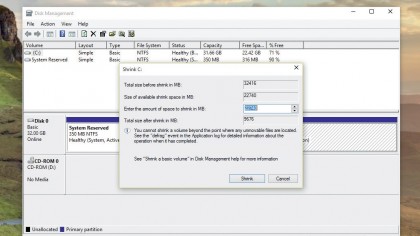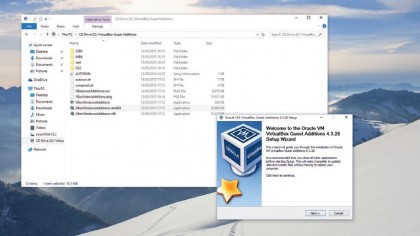How to install Windows 10
Time to upgrade
We're going to show you how you can install Windows 10 if you don't want to go for the simple in-OS upgrade.
This will be either a clean install or a virtual machine install. The latter will leave your current machine pristine – perfect for testing out the advanced features of Windows 10 without the risk of losing any data.
The clean install
Let's start with a clean install. If you have a copy of Windows 10 on DVD, put it in your optical drive, restart your machine, and it'll boot from the disc. If it doesn't, you'll likely need to change a setting in your computer's BIOS/UEFI to put the optical drive first in the boot order.
We can't be specific about exactly what setting to change and how, given the wide variety of BIOS and UEFI systems out there, but watch out for a message displayed on your PC's screen at boot time – you might see a small window in which to hit an allotted key, usually [F2] or [Del]. If you know the model of your PC, or the model of your motherboard in the case of custom-built desktop PCs, check your manufacturer's website for further instructions.
The above process is also true if you've transferred an ISO image to USB for installation; while there are a few more steps to take before you can get started as long as your install media is set to boot first, you'll be fine. You'll probably need to ensure you have your drive inserted into a port before you boot to BIOS in order to set this up.
The actual installation process couldn't be easier, particularly if you've installed Windows 8.1 or Windows 7 from scratch before. Once you're running the installer, just follow the instructions displayed on screen. The Windows 10 install process is even more simple and foolproof than ever before, and if you're careful not to let it overwrite a partition you're using, you'll likely have no problem.
But wait! Hold fire if you're looking to dual boot Windows 10 with Windows 7 or Windows 8.1; before you install, unless you already happen to have a spare partition, you'll need to use the Disk Management tool within your old OS to resize your primary partition and separate off a little space for Windows 10 to install into.
Are you a pro? Subscribe to our newsletter
Sign up to the TechRadar Pro newsletter to get all the top news, opinion, features and guidance your business needs to succeed!
The tools are almost identical in each OS. But wait… again! Before you can resize your main partition effectively, you'll need to make sure all of your files are arranged by defragmenting it, leaving a portion of space at the end to be reallocated.
Right click your primary drive in Windows Explorer, select 'Properties', open the Tools tab, and click 'Defragment now'. Now just click Defragment Disk to start the process.

Disk Management
Launch the Disk Management tool by opening the run dialog with [Windows]+[R] then typing diskmgmt.msc. The interface shows the partitions that exist on your machine – you'll probably have at least two, a small recovery partition and a much larger main partition, and it's the latter we're interested in.
Check in the volumes list at the top of the window that your chosen partition has enough free space (at least 16GB for 32-bit Windows 10 and 20GB for 64-bit, though we'd obviously recommend allocating a fair amount more). If you're short on space, you'll need to clear some files before continuing.
Right click your target drive in the Disk Management tool and select 'Shrink Volume', then input the amount of space you're looking to claw back. Be aware that the tool is looking for this in MB rather than GB, so add three zeroes to the end of your intended space in GB.
Click 'OK' and the tool will go to work, and you'll be left with an area on your drive labelled 'unallocated space'. We now need to turn this into a partition. Right click it, select 'new simple volume', and click 'Next'. You can give this new partition any letter you like.
Keep clicking 'Next' until you see the formatting options. Make sure you choose 'NTFS' as the file system, and label your drive ('Windows 10' perhaps?) before formatting the space. If you ever want to revert the changes and get the space back, you can use Disk Management's Delete Volume and Extend Volume tools to expand your primary partition once more.

Go virtual
A final option, if you're looking to test Windows 10 in a non-destructive way, is to install it inside a virtual machine. You can do this with any kind of media – DVD, USB or ISO – and though you'll suffer a performance hit, this method gives you the chance to experiment without any risk.
Grab the latest version of VirtualBox, install it (and its components), and run it. Click the 'New' button, type in a name, select the appropriate version of Windows 10 in the Version drop down list, and click 'Next'. Leave all of the settings at their defaults, and click 'Next' and 'OK' until you see your new install added to the main VirtualBox interface.
Now, with that VM selected, click 'Settings', go to the Storage page, click the disc marked 'Empty' under 'Controller: IDE', then the CD icon on the right-hand side of the window. Choose the appropriate install drive (or disc image, if you're using an ISO file) then click 'OK'. Click the 'Start' button, and your install will commence.
Media guide
If you've downloaded an ISO version of Windows 10, you'll need to turn this into valid bootable media before you can install it. If you have a writeable disc like a DVD-R, this is super easy: just pop it into your PC's drive, right-click the ISO, and select the appropriate option to burn it straight to the disc.
To transfer your ISO to a bootable USB stick, first make sure your target stick has a capacity of at least 8GB, and remove any files you want to keep, as the drive will be completely wiped as part of the process. Next, download Microsoft's Windows 7 USB/DVD Download Tool – ignore the name, this is valid for any version of Windows – install it, run it, and select the ISO file you've downloaded as the source and your USB drive as the destination. Let it run, and you'll soon have a bootable USB stick ready to install Windows 10 on your target machine.
Current page: Which way to install Windows 10?
Prev Page How to install Windows 10 Next Page What to do before you install